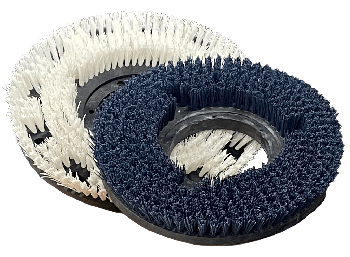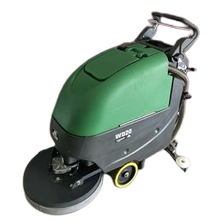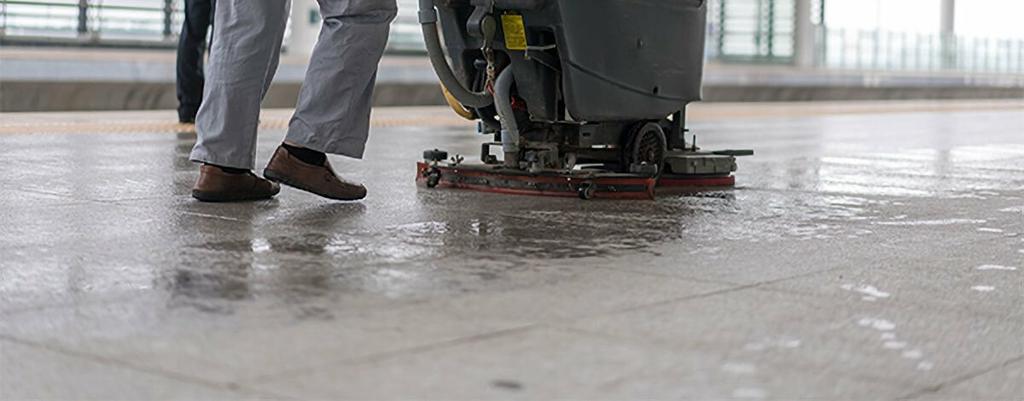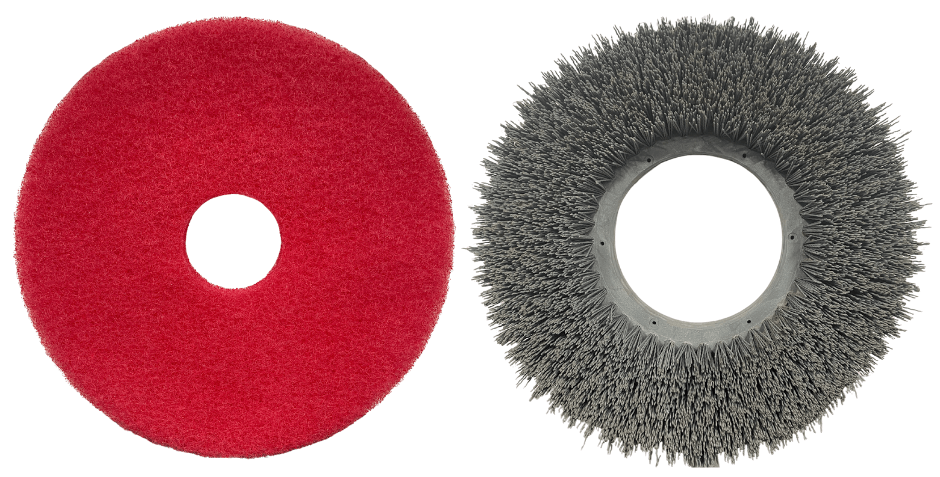Scrub Pads vs. Scrub Brushes: Which is Right for Your Floors?

The cleaning performance of your floor scrubber largely depends on the scrubbing tool you choose. All automatic floor scrubbers with a disc style scrub deck can be equipped with either scrub brushes or scrub pads. Both are available in a wide range of options for different applications, but how do you know whether brushes or pads will work best for your facility?
Continue reading to learn the differences between pads and brushes and what to consider when choosing between them, such as type of flooring, level of soil, durability, and cost.
Differences Between Scrub Pads & Scrub Brushes
Although pads and brushes can be used interchangeably for some cleaning tasks, their differences in design and function often make one more suitable than the other in certain circumstances. Understanding these differences will help you choose the best option for your facility.
Scrub Pads
Floor scrubber pads are disc-shaped abrasive scrubbing tools that are about 1” thick. Made of non-woven fibers and abrasives, pads are typically color-coded by level of abrasiveness. Pads are designed to provide consistent surface contact, allowing them to effectively clean, polish, and remove scuffs from smooth surfaces.
Click here to learn more about scrub pads
Scrub Brushes
Disc* scrub brushes, by contrast, feature 1.5” to 2” long bristles arranged in a circular pattern around a central attachment point. Varying in abrasiveness, brush bristles are commonly made from wire, polypropylene, nylon, or carbide grit-infused fibers. Brushes are designed to agitate and lift dirt from surfaces, offering a deeper clean with sturdy yet flexible bristles that can reach into cracks and crevices.
*Floor scrubber brushes are available in both disc and cylindrical forms, depending on the type of scrub deck on your machine. For the sake of comparing brushes and pads in this article, we’re focusing on disc brushes as they are the only style of brush that is interchangeable with pads.
Click here to learn more about scrub brushes
Key Factors to Consider
When deciding between pads and brushes, it’s important to consider each of the following factors to determine which will more effectively clean your facility.
1. Equipment Compatibility
Pads and disc brushes are compatible with all automatic floor scrubbers equipped with a disc scrub deck. However, when switching from brushes to pads, a pad driver needs to be installed to hold the pad in place. Conversely, when switching from pads to brushes, the pad driver must be removed.
While this shouldn't discourage you from switching between the two, it's an important factor to consider. If you’re unable to install or remove the pad driver yourself, one of our service technicians can handle it for you. Just call us at (888) 834-9948 or email service@triadservice.com.
2. Floor Type
Smooth floors (e.g., terrazzo, vinyl, linoleum, hardwood, polished stone/concrete, etc.)
Pads provide consistent contact with smooth surfaces, allowing them to clean and maintain the shine on polished floors more effectively than brushes. As they are generally softer than brushes, pads are also more gentle* on sensitive flooring.
*Warning: Not all pads are created equally gentle! Use caution when choosing the grit and always test new pads (of increased abrasion) in an inconspicuous, low-traffic area in case it is too aggressive and causes damage.
Textured or uneven floors (e.g., tile with grout lines, rough concrete, anti-slip/slip-resistant flooring, etc.)
On uneven or textured surfaces, brushes maintain better contact by fitting into grooves and gaps that pads can’t reach. Brushes also provide greater agitation, making them a more effective choice for use on rough floors. Furthermore, brushes are more durable and don’t wear down as quickly—whereas rough surfaces easily shred pads, leading to more frequent replacements.
3. Soil Level
Light to moderate soil
Both pads and brushes are suitable for removing light to moderate soil such as dust, dirt, and scuff marks. With that in mind, this level of soil won't be a deciding factor for choosing one over the other.
Heavy soil, grease, or sticky residues
For outdoor cleaning and removing more stubborn substances such as grease, grime, compacted dirt, or sticky residue, brushes offer more effective agitation and stronger cleaning power.
4. Durability
Pad Durability
Typically, pads deteriorate more quickly than brushes because they are made of softer materials. This is particularly true when operating on abrasive or uneven surfaces.
Depending on how often you use your machine, the estimated frequency of scrub pad replacements is as follows:
|
If you use your scrubber: |
Replace your pads every: |
|---|---|
|
2-3x/day |
Month |
|
1x/day |
1-2 months |
|
3-5x/week |
3 months |
|
1x/week |
3-6 months |
|
1-2x/month |
6 months - 1 year |
Brush Durability
Brushes tend to be more durable and have a longer lifespan than pads, especially when used on rough or textured flooring.
Refer to the chart below for the estimated frequency of scrub brush replacements based on machine use:
|
If you use your scrubber: |
Replace your brushes every: |
|---|---|
|
2-3x/day |
1-2 months |
|
1x/day |
3 months |
|
3-5x/week |
3-6 months |
|
1x/week |
6 months-1 year |
|
1-2x/month |
Year |
TIP: Both brushes and pads should be rinsed off after use to extend their lifespan and maintain prevent build up of debris that will reduce your machine's efficiency.
5. Cost
Pad Cost
While pads are cheaper upfront, they need to be replaced more frequently than brushes. This means you may end up paying more in the long run than you might by using brushes.
Brush Cost
Brushes are more expensive initially but can offer longer-term value as they don’t need to be replaced as often as pads.
Side-by-Side Comparison
To further help you decide between scrub pads and scrub brushes, check out the chart below for a quick overview of how they compare.
|
Feature: |
Scrub Pads: |
Scrub Brushes: |
|---|---|---|
|
Equipment Compatibility |
Only compatible with disc scrub deck and requires installation of a pad driver |
Only compatible with disc scrub deck |
|
Surface Compatibility |
Best for smooth floors |
Best for textured/uneven floors |
|
Soil Level Cleaning Power |
Light to moderate soil |
Light to heavy soil |
|
Durability |
Low |
High |
|
Cost |
Lower upfront, potentially higher long-term |
Higher upfront, potentially lower long-term |
Ultimately, choosing between scrub pads and scrub brushes comes down to understanding your facility’s specific cleaning needs. While both are effective, their differences in design, durability, and performance on various surfaces make each better suited for certain applications. By considering factors like floor type, soil level, durability, and cost, you can make a more informed decision that maximizes your floor scrubber’s performance and extends the life of your scrubbing tools.
If you're still unsure which option is right for your facility, we're here to help!
Call us: (888) 834-9948
Email us: parts@triadservice.com
Check out our free downloadable buying guide:
Learn more about:
Disclaimer: Please keep in mind that this article is designed to act as a generalized overview and comparison of scrub brushes and scrub pads. Grit and material of brushes and pads should also be taken into consideration when deciding the best option for your floor and cleaning goals.
©















